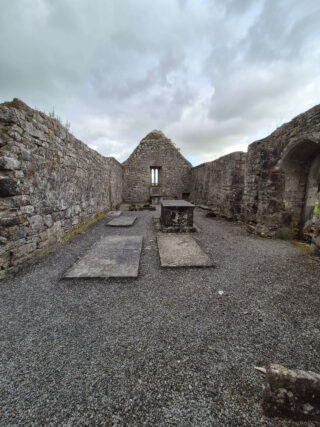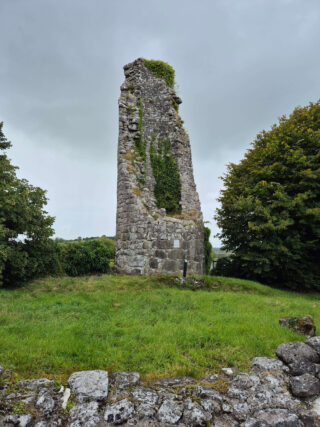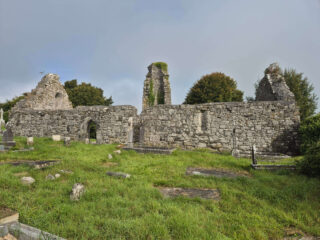Notice
Drumcliffe Church & Round Tower is a National Monument in state guardianship
WARNING: It should be noted that these sites are unguided and a level of care and caution should be maintained during all stages of your visit. The Office Of Public Works (OPW) will not be held responsible for any damages, injuries, or losses that occur
Drumcliffe Church and Round Tower
Located two miles north of Ennis, Drumcliffe church and its adjacent round tower is thought to be one of the earliest mission churches in Clare, dating from c.600 A.D. Drumcliffe was the site of a monastic settlement since early Christian times, until it was briefly transformed into a Protestant chapel during the reformation. Today, Drumcliffe contains the main cemetery for the town of Ennis, which includes the old graveyard located beside to the now ruined church and round tower. Very little is known of the history of the monastery, possibly because of Viking raids. This is evidenced by a nearby location known as Poulnaclug, where church bells were said to have been thrown in the event of an attack.
It is thought that the foundation of the church dates from the early 6th century, making it one of the oldest foundation churches in Clare. Although St. Brecon is generally associated with the foundation of early Christian churches in Clare, many believe Drumcliffe church may in fact be associated with St. Connell. After the reformation in the 16th century, the church was briefly used as a Protestant chapel, until a new chapel was built at the Friary in Ennis. The adjoining graveyard later became the main burial site for the town of Ennis, following the closure of the graveyard at Ennis Friary in the late 18th century.
The present church structure, standing at 58ft long and 21ft wide, contains several different phases of construction, due to a number of renovations over the years. While most of the structure dates from the 15th century, features of the original pre-Norman church remain, as well as a round window dating from c.1200 which was used in a 15th century rebuild. The east gable also contains a late gothic window. The church served as the main parish church until the penal times, when it was used briefly as a protestant chapel, and is believed to have been abandoned sometime before 1734. Drumcliffe round tower, known as Clogas Droma Cleibh, is located 31ft from the church, and is believed to date back to the 10th century. The structure was in a good state of preservation in 1808, however it has long since deteriorated, possibly as the result of a lightning strike. Consequently, the doorway, which would have been located above ground level, is no longer present. Round towers, such as this one, are generally believed to have served as security lookouts, repositories for valuables, and as bell towers. The adjoining graveyard contains several burial vaults belonging to prominent families from the area. It is also believed that stones from the southwest face of the church were removed and used as grave markers. The graveyard also contains a famine plot, thought to contain 2000 people, and an adjacent cholera grave. A paupers grave, dating from the 1880s, is also present at the site, and was in use until the 1950s. In 2010, a monument was erected in the graveyard to commemorate the ‘many disadvantaged people’ interred in these plots.
Visit Historic Environment Viewer for more information on Drumcliffe Church & Round Tower
Protect our Past - Click here to read about the importance of protecting our country’s unique heritage sites
This national monument is protected in accordance with the National Monuments Acts 1930 to 2014
Gallery
Nearby sites to visit
Ennis Friary
Admire some exquisite Renaissance carvings
Approx. 2.7 km from Drumcliffe Church and Round Tower
Askeaton Castle
A ruined stronghold of the earls of Desmond
Approx. 29.8 km from Drumcliffe Church and Round Tower
Adare Castle
Discover a medieval masterpiece, built for defence
Approx. 36.5 km from Drumcliffe Church and Round Tower
Scattery Island Monastic Site and Visitor Centre
Discover the History, Myth and Legend of Scattery Island
Approx. 45.2 km from Drumcliffe Church and Round Tower
Desmond Castle Newcastlewest
Where sounds of medieval revelry echo around the walls
Approx. 46.6 km from Drumcliffe Church and Round Tower
Lough Gur Visitor Centre and Lakeshore Park
9,000 years of life
Approx. 50.0 km from Drumcliffe Church and Round Tower




